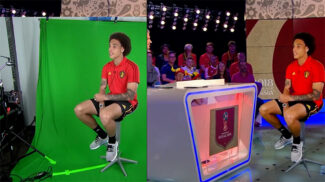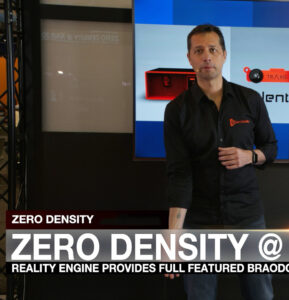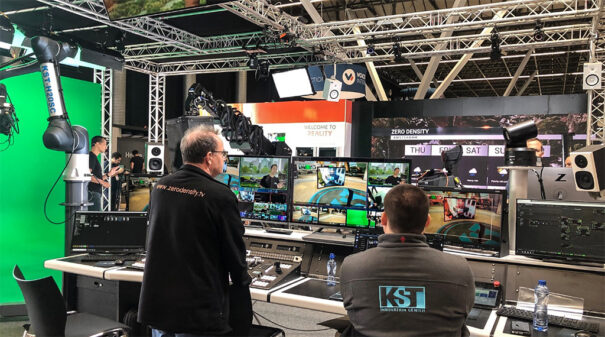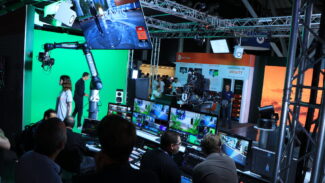Gráficos fotorrealistas de realidad aumentada en televisión: una nueva era
La realidad aumentada ofrece un sinfín de oportunidades para la industria de la televisión en términos de experiencia del espectador, narración de historias y visualización de datos. Ahmet Oturgan, responsable de desarrollo de negocio para el sur de Europa de Zero Density, cuenta en esta tribuna cómo esta solución ayuda a contar historias con efectos visuales impresionantes y ofrece formas interactivas para que la audiencia forme parte de la historia.
Los gráficos de realidad aumentada pueden utilizarse para explicar o mostrar al público cualquier cosa: desde acontecimientos históricos de calado hasta condiciones meteorológicas peligrosas o datos electorales. Puedes enriquecer tu contenido con RA (Realidad Aumentada) representando lo que fue, es o será la situación o el impacto, para que la audiencia, de esta forma, se enganche al contenido.
 La RA también permite trabajar a distancia. Los equipos de producción no necesitan desplazarse a diferentes lugares para obtener imágenes relacionadas con la historia que quieren contar. ¡Puedes sentarte en tu estudio de producción y utilizar la RA para mostrar al público todo lo que desees! Incluso puedes “teletransportar” a actores y presentadores de todo el mundo para que aparezcan en forma de superposición gráfica.
La RA también permite trabajar a distancia. Los equipos de producción no necesitan desplazarse a diferentes lugares para obtener imágenes relacionadas con la historia que quieren contar. ¡Puedes sentarte en tu estudio de producción y utilizar la RA para mostrar al público todo lo que desees! Incluso puedes “teletransportar” a actores y presentadores de todo el mundo para que aparezcan en forma de superposición gráfica.
Cambiar los decorados físicos puede resultar difícil, pero la RA proporciona flexibilidad para dar un cambio de imagen a tu estudio, ya que puedes incluso editar los gráficos en el último momento y hacer que los cambios aparezcan al instante en el montaje final. Esto también reduce el tiempo que se pasa en el plató.
Los motores nacidos como soluciones para videojuegos, como Unreal Engine, son lo suficientemente potentes como para renderizar enormes paisajes en tiempo real. Ahora, más que nunca, podemos ver cómo las cadenas de televisión de todo el mundo emplean RA tanto para programas diarios como para segmentos concretos que captan la atención del espectador al instante. La realidad aumentada en las emisiones de televisión no es nada nuevo; el nivel de fotorrealismo sí lo es.
Fotorrealismo y storytelling
Los broadcasters cubren una amplia gama de temas de gran calado como las noticias de última hora, la economía, las elecciones, los deportes y el tiempo. Mostrar estos temas de forma comprensible y agradable a la vista se erige como una clave que garantizará que la audiencia quede fascinada y enganchada al contenido. La realidad aumentada entra en escena como una tecnología rápida, accesible y eficaz. Además, cuando la narración es fotorrealista, la calidad de la emisión alcanza nuevas cotas.
Recientemente, en IBC 2022 (al igual que en NAB 2022), Zero Density hizo una demostración detallada de cómo los gráficos fotorrealistas de realidad aumentada podían ayudar a los broadcasters a mejorar todo su flujo de trabajo: desde la experiencia del espectador hasta la narración y los flujos de trabajo basados en datos.
Para entender mejor la creación de gráficos virtuales que sean realistas para el ojo humano, hay que saber que se estructura en torno a tres grandes elementos: capacidad de renderizado en vivo, sombras realistas en directo y reflejos realistas en tiempo real.
Renderización
Los renderizadores de emisión han recorrido un largo camino. El equipo de Zero Density se convirtió en el primero en adoptar un motor de videojuegos para el ámbito broadcast allá por 2016. La empresa transformó Unreal Engine modificando su código fuente para cumplir los requisitos de la producción en directo y desarrolló tanto un compositor basado en nodos como un keyer basado en imágenes; ambas, herramientas que funcionaban en tiempo real. Este conjunto de soluciones proporciona todas las herramientas necesarias para que los usuarios puedan crear imágenes impresionantes con la máxima fidelidad, estabilidad y flexibilidad.
Los visitantes de IBC 2022, al ver la demostración de Zero Density, se sorprendieron de los resultados fotorrealistas y se preguntaron dónde estaban los racks de equipos necesarios para crear la composición. Fue una gran sorpresa para ellos ver que todo el procesamiento, incluyendo la entrada y salida de vídeo, el keying, el renderizado y la composición, procedía de una sola estación de trabajo. A día de hoy, muchos ya se han dado cuenta de que los motores de juegos renderizan gráficos más fotorrealistas que los motores de emisión y han empezado a adoptarlos en sus flujos de trabajo.
Para alcanzar el fotorrealismo se necesita un renderizador de ray tracing y un compositor 3D en tiempo real como Reality Engine.
Reality Engine, el compositor basado en nodos en tiempo real, puede teclear, rastrear, renderizar y componer gráficos fotorrealistas en tiempo real y ha sido construido de forma nativa para aprovechar las características de Unreal Engine. Esto hace que los gráficos de realidad aumentada sean más fotorrealistas.
Además, los gráficos de realidad aumentada de la presentación de Zero Density son compatibles con ray tracing, lo que demuestra que es posible obtener imágenes de calidad cinematográfica para gráficos ultrarrealistas en directo compuestos con vídeo en directo. Para alcanzar este nivel de fidelidad de imagen se necesita un renderizador de ray tracing y un compositor 3D en tiempo real como Reality Engine.
What an epic last day at @IBCShow! Just like the first days, it was still jam-packed at the Zero Density booth.
ZD team’s sincere thanks go to IBC Show 2022 for the exceptional organization, to numerous technology enthusiasts who paid a visit to our booth or followed us online. pic.twitter.com/NmjsLH8bgX
— ZeroDensity (@0Density) September 13, 2022
Reflejos y sombras
En las producciones de realidad aumentada, la mezcla de lo virtual y lo real puede mejorarse a menudo. Como se ve en la demostración del IBC Show, el presentador proyecta sus reflejos automáticamente sobre los gráficos de RA, creando una experiencia visual mejorada para la audiencia. Al añadir un producto de seguimiento de talentos como Traxis talentS en la fórmula, como el sistema conoce la posición exacta del talento dentro del espacio físico, los reflejos creados sobre los gráficos AR se renderizarán en la posición correcta automáticamente. Del mismo modo, este sistema permite que se pueda interactuar directamente con los gráficos. En definitiva, TRAXIS talentS permite automatizar los disparos de los gráficos AR cuando el presentador se desplaza a una zona específica del plató físico.
Una clave adicional. Si quieres que tus gráficos parezcan más naturales y se integren perfectamente en el estudio, asegúrate de que las sombras virtuales coincidan con las luces físicas y de que tus objetos reflectantes reflejen siempre todo el entorno.
 Blending
Blending
Por último, pero no por ello menos importante, una característica única de Reality Engine es la composición de gráficos con varios modos de blending similares a los de Photoshop, pero en tiempo real. Puedes añadir bloom y lens flares mezclados de forma aditiva sobre el tercio inferior o aplicar un efecto de desenfoque en el fondo del tercio inferior sobre la señal de vídeo entrante.
Basado en datos
La visualización de datos de RA ofrece un gran valor. Destaca sobre el contenido en 2D y asegura que los espectadores sigan con atención el programa durante el tiempo. Una vez que se han diseñado y compuesto todos los activos 3D en el entorno del plató físico o virtual, la última pieza del rompecabezas consiste en utilizar una aplicación de control como RealityHub para alimentar esos gráficos con datos. Un artista 3D puede descargar los gráficos de RA, modificarlos y tenerlos listos en un par de horas, pero la producción no será funcional hasta que se pueda controlar en tiempo real. Eso es lo que marca una gran diferencia. Con una aplicación de control como RealityHub, un diseñador puede controlar el tiempo de la animación y vincular las elecciones en tiempo real, los deportes y otros datos directamente a los gráficos.
Por ejemplo, RealityHub puede utilizar datos de cualquier fuente que sirva para alimentar los gráficos, como un archivo Excel local o una fuente de datos en directo, sin necesidad de utilizar ningún complemento adicional ni de escribir una sola línea de código. RealityHub viene con un completo conjunto de herramientas para integrar cualquier fuente de datos externa y ayuda a los usuarios a visualizar información compleja a la audiencia sin la complejidad en la preparación. Asegúrate de incluir gráficos basados en datos a tu canal de RA para simplificar todos los procesos y ofrecer una experiencia inspiradora al espectador.
El futuro del broadcast
La naturaleza inmersiva de la realidad aumentada permite a las emisoras añadir una nueva dimensión y dinámica a sus programas, lo que resulta en un atractivo para la audiencia sin precedentes. Está demostrado que la RA no es una moda, sino el futuro del broadcast. Con la realidad aumentada evolucionando rápidamente y haciéndose más y más versátil cada día, las posibilidades se vuelven infinitas para los broadcasters, por lo que necesitan utilizar una tecnología de RA que pueda seguir el ritmo de su producción e innovación. La tecnología Zero Density te permitirá ofrecer los gráficos de RA más fotorrealistas posibles que satisfagan su visión creativa y la calidad prevista, ahora y en el futuro.
Con la realidad aumentada evolucionando rápidamente y haciéndose más y más versátil cada día, las posibilidades se vuelven infinitas para los broadcasters.
Con Unreal Engine 5 a la vuelta de la esquina, estamos pudiendo comprobar cómo más y más artistas 3D empiezan a utilizar Unreal Engine como motor principal: ¡la solución ya no es solo para juegos! Cualquiera que tenga curiosidad por aprender sobre la creación de gráficos en tiempo real, le recomiendo que se dirija al sitio web de Epic Games: tienen un montón de cursos gratuitos para empezar. También recomendaría descargar la edición gratuita para la comunidad de nuestro software de composición en tiempo real, Reality Engine, e ir a nuestra Zero Density Academy para ver algunos vídeos con los que empezar a experimentar rápidamente.
Ahmet Oturgan
Responsable de desarrollo de negocio para el sur de Europa de Zero Density.
¿Te gustó este artículo?
Suscríbete a nuestro NEWSLETTER y no te perderás nada.




